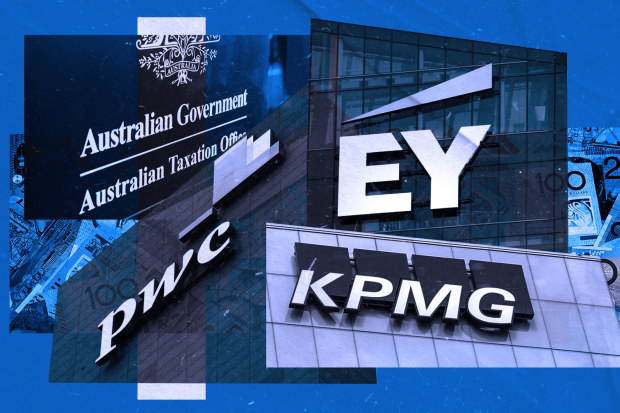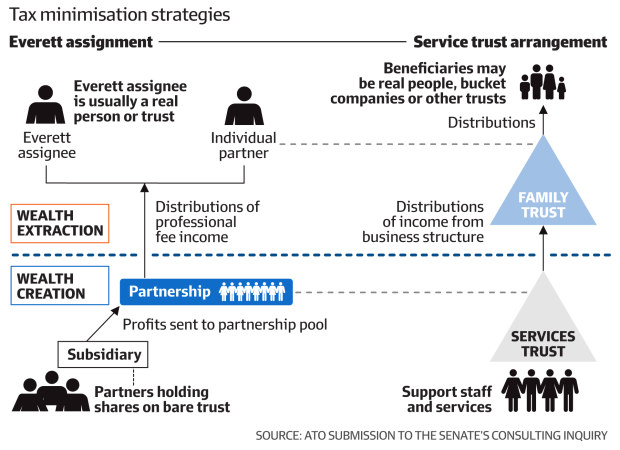Big four partners split 44pc of income to cut tax bill: ATO
Big four consulting firm partners distributed $1.2 billion, or 44 per cent, of their collective $2.7 billion profit via trusts and other income splitting measures in the 2022 financial year to cut their tax bill, a Senate inquiry has been told.
The Australian Tax Office said the income directed to the different types of trusts were “highly likely to be subject to lower tax rates” than if they were paid directly to equity partners.

Greens senator Barbara Pocock said Big four partners typically split a portion of their income. Michaela Pollock
The tax office said that, as an example, the lower tax rate for the distributed income was likely to be 30 per cent. This is lower than the top tax rate of 45 per cent for every dollar earned over $180,000. Equity partners at the big four firms take home an average income of at least $700,000.
The fresh details of how partners cut their tax bills were revealed after the ATO signalled it would crack down on the use of the common tax minimisation schemes used by partners at big four consultancies.
Treasury has also flagged intensified scrutiny of the use of discretionary trusts, which are becoming increasingly popular as a tax minimisation method.
Senators have criticised the use of income splitting techniques by big four partners, but others say distributing income to reduce tax is a legal technique available to partners because they are part owners of the business.
Effective tax rate of 36pc
The Tax Office, in response to questions from Greens senator Barbara Pocock, said it was not possible to estimate how much tax was paid on an individual partner’s distributions when the income was split because it would require “considerable ATO resources” to trace the ultimate beneficiary.
The exercise would also require significant judgment calls by ATO to calculate.
But the ATO estimated that the effective tax rates for partners worked out to about 36 per cent across the big four firms.
The firms have provided their own average partner tax rates, which ranged from 40 per cent (KPMG) to 39 per cent (EY) and 37 per cent (PwC and Deloitte).
The ATO said of the total $2.7 billion in taxable income to equity holders at the big four firms for the 2022 financial year, “$1 billion of taxable income distributed from their associated service trusts or similar entities” and another $200 million in income “was reported as distributed to family trusts”. A component of this $200 million was split using Everett assignments.

Income-splitting structures
Partners, as owners of the business, can use two income-splitting measures. The first, known as an Everett assignment, involves partners assigning a portion of their stake in the partnership and its future income to others, usually a spouse, to cut their own overall tax bill.
The second common arrangement involves using a service trust, controlled by the firm’s partners, to provide labour, recruitment and other services to the partnership at a marked-up price, which results in a reduction of taxable partnership income. Profits from the trust can then be distributed to a family company, trust or spouse.
The ATO noted that individual partner tax returns did not include details of the taxable income from service trusts as these details “will usually be received and returned by associated individuals or entities ... [that] pay tax on that income”.
“Similarly, if there has been an Everett assignment of some of the partner’s interest in the partnership, that taxable income will be received and returned by associated individuals or entities,” the ATO said.
The Tax Office noted that partners are taxed on their full distribution even if a portion is withheld to fund capital investments and other business activities within the firm.
This means the “tax rates borne by partners and their associates are increased”.
ATO crackdown
The Tax Office changed its rules around the Everett assignment in 2020 as part of a crackdown on its use by professional services partners.
At the time, the ATO then warned it was “concerned about high-risk arrangements in all professional firms” and foreshadowed “increased enforcement action” ahead of new guidelines set to govern “Everett assignments” that have been issued but do not come into effect until July.
This new, risk-based, approach by the ATO to income splitting by partnerships will focus on income allocations that are distorted because they are driven by tax purposes.
Deloitte amended its partnership agreement almost a decade ago to prohibit the use of Everett assignments by its partners, while PwC has recently banned partners from entering into any new assignments.
KPMG and EY continue to allow their partners to use Everett assignments to lower their taxable income.
About 230 of PwC’s partnership of between 750 and 780, or about 30 per cent, used the Everett assignment, while less than 20 per cent of KPMG’s 700-strong partnership used the assignment.
EY estimates that about 30 per cent of the firm’s 760-odd partners used the structure.
Find out the inside scoop about Accenture, Deloitte, EY, KPMG, PwC and McKinsey. Sign up to our weekly Professional Life newsletter.


